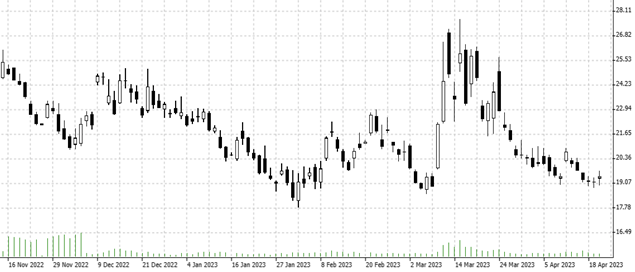

21.04.2023 –For a good two weeks now, Wall Street has been moving almost steadily upwards. Investors seem to have ticked off the various crises, as a glance at the VIX shows. The fear indicator is approaching carefree territory. Reason enough to hedge your bets.
US banking crisis, Ukraine war, possible invasion of Taiwan – was there anything? All apparently already forgotten. The VIX – here the daily chart, more precisely: this is the mini future on the VIX – has returned to the level of before the bank turbulences. And also almost to the level before the Russian invasion. Which is surprising, given the growing signs of a major Ukrainian offensive – with possible nuclear escalation or regime change in Moscow

Source: Bernstein Bank GmbH
The VIX is the volatility index of the Chicago Board Options Exchange. The indicator measures the expected range of fluctuation of the S&P 500. Now it is approaching the territory where traders and investors might want to think about a favorable protective put. After all, you buy the hedge when you don’t need it. Because the next run up is sure to come. The only question is when.
Looking at the Fed
Apart from the potential trouble spots just mentioned, the question of monetary policy naturally continues to hover in the air. If the Federal Reserve does continue with a spirited tightening, it should surprise all those who believe that the end of rate hikes is now almost here. Even higher rates are quite possible if the Fed sees no danger of a recession, but continues to view inflation as its main enemy number one. An unexpected rate hike should send stocks down and the VIX up. So in the relative calm before the Weekend, let’s turn our attention to the latest Fed Speak from voting members of the central bank.
Focus inflation remains
Governor Michelle W. Bowman just emphasized that the Fed remains focused on fighting inflation. A strong labor market, she said, is making it enormously difficult to find new hires. We think: So she fears a wage-price spiral. However, Bowman says there could be a small downturn in the coming year as banks issue less credit. Christopher J. Waller, also from the Board of Governors, noted, however, with regard to the collapsed Silicon Valley Bank, that the situation at the banks has largely calmed down.
Further, Patrick Timothy Harker, president of the Federal Reserve Bank of Philadelphia, explained that the tightening must continue for a bit. And if it ends, he said, the interest rate will have to stay at the higher level for a while. And Lorie K. Logan, head of the Dallas Fed, judged that inflation is simply too high and that the central bank must examine whether it is really declining.
Our conclusion from all this is that the turmoil at the financial institutions seems to have been averted, and a severe economic crisis is not in sight. But inflation is holding up. This gives the Fed some arguments to raise interest rates further and then keep them up. We are curious when this will be reflected in the figures of the companies. So always keep an eye on the real-time news. When there are too many optimists on the trading floor, a small scare is often enough to cause prices to dive. Whether long or short – Bernstein Bank wishes you successful trades and investments!
_________________________________________________________________________
The content of this publication is for general information purposes only. In this context, it is neither an individual investment recommendation or advice nor an offer to purchase or sell securities or other financial products. The content in question and all the information contained therein do not in any way replace individual investor- or investment-oriented advice. No reliable forecast or indication for the future is possible with respect to any presentation or information on the present or past performance of the relevant underlying assets. All information and data presented in this publication are based on reliable sources. However, Bernstein Bank does not guarantee that the information and data contained in this publication is up-to-date, correct and complete. Securities traded on the financial markets are subject to price fluctuations. A contract for difference (CFD) is also a financial instrument with leverage effect. Against this backdrop, CFD trading involves a high risk up to the point of total loss and may not be suitable for all investors. Therefore, make sure that you have fully understood all the correlating risks. If necessary, ask for independent advice. CFDs are complex instruments and are associated with the high risk of losing money quickly because of the leverage effect. 68% of retail investor accounts lose money trading CFD with this provider. You should consider whether you understand how CFD work and whether you can afford to take the high risk of losing your money.7
